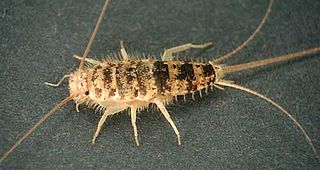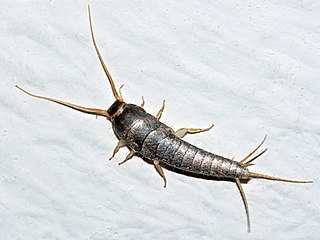
The firebrat is a small insect, in the order Zygentoma.

Lepismatidae is a family of primitive wingless insects with about 190 described species. This family contains the two most familiar members of the order Zygentoma: the silverfish and the firebrat. It is one of five families in the order Zygentoma.

Zygentoma are an order in the class Insecta, and consist of about 550 known species. The Zygentoma include the so-called silverfish or fishmoths, and the firebrats. A conspicuous feature of the order are the three long caudal filaments. The two lateral filaments are cerci, and the medial one is an epiproct or appendix dorsalis. In this they resemble the Archaeognatha, although the cerci of Zygentoma, unlike in the latter order, are nearly as long as the epiproct.

Ctenolepisma is a genus of primitive insects in the order Zygentoma, closely related to the silverfish and firebrat but less reliant on human habitation, some species being found both indoors and outdoors and some found exclusively outdoors. The genus is distributed nearly worldwide in warm regions. Australia lacks native Ctenolepisma, but is home to introduced species.

Ctenolepisma lineatum is a species of insect of the order Zygentoma. It is similar to the closely related silverfish but can be distinguished by being rather stouter and less shiny with all appendages noticeably longer. The abdomen is often marked with dark brown lines and the species is sometimes called four-lined silverfish.

The silverfish is a species of small, primitive, wingless insect in the order Zygentoma. Its common name derives from the insect's silvery light grey colour, combined with the fish-like appearance of its movements. The scientific name indicates that the silverfish's diet consists of carbohydrates such as sugar or starches. While the common name silverfish is used throughout the global literature to refer to various species of Zygentoma, the Entomological Society of America restricts use of the term solely for Lepisma saccharinum.

Tricholepidion is a genus of wingless insect belonging to Zygentoma, with only a single described species T. gertschi, native to the northern coast of California in Western North America. It lives under dead bark and in rotting wood of conifers in mesophytic forests. It is alternatively considered the only living member of the family Lepidotrichidae, which also includes Lepidotrix from Eocene aged European amber, or the only member of the family Tricholepidiidae. The taxonomic position of Tricholepidion is uncertain, in some molecular phylogenetics studies it has been recovered as less closely related to flying insects (Pterygota) than the rest of Zygentoma is, rendering Zygentoma paraphyletic. Each compound eye contains ~40 ommatidia, and they have three ocelli. Scales on the body are absent. Unlike Archaeognatha and the other families of Zygentoma, which have three- and sometimes two-segmented tarsi, they have five-segmented tarsi like many winged insects.
Ctenolepisma algharbicum is a species of silverfish in the family Lepismatidae.
Ctenolepisma electrans is a species of silverfish in the family Lepismatidae.
Ctenolepisma guadianicum is a species of silverfish in the family Lepismatidae. Like all silverfish, guadianicum prefers very humid environments, although some members of Thysanura have evolved minor adaptations to alter this. Guadianicum, similar to the vast majority of the near four hundred discovered silverfish, lives outdoors, under detritus, leaves, and other fallen forest debris. This silverfish is grey in appearance, less than an inch long, with an oblong body shape. All members of Ctenolepisma have lengthy, angled antennae that extend from their head and reach towards their abdomen. Guadianicum also lacks wings, has three pairs of legs, and has abdomen appendages appearing similar to antennae. Unlike the indoor dwelling silverfish species, guadianicum is not considered a pest, however, this means that little else is known about this particular species discovered in the 1990s.
Ctenolepisma insulicola is a species of silverfish in the family Lepismatidae.
Sceletolepisma michaelseni is a species of silverfish in the family Lepismatidae.
Ctenolepisma rothschildi is a species of silverfish in the family Lepismatidae. It is found in Africa, Australia, the Caribbean Sea, Europe and Northern Asia, Central America, North America, Oceania, South America, and Southern Asia.
Ctenolepisma tanzanicum is a species of silverfish in the family Lepismatidae.
Ctenolepisma targionianum is a species of silverfish in the family Lepismatidae.
Ctenolepisma targionii is a species of silverfish in the family Lepismatidae. It is found in North America.
Ctenolepisma terebrans is a species of silverfish in the family Lepismatidae.
Ctenolepisma versluysi is a species of silverfish in the family Lepismatidae.
Ctenolepisma vieirai is a species of silverfish in the family Lepismatidae. It is found in Europe.

Ctenolepisma longicaudatum, generally known as the gray silverfish, long-tailed silverfish or paper silverfish, is a species of Zygentoma in the family Lepismatidae. It was described by the German entomologist Karl Leopold Escherich in 1905 based on specimens collected in South Africa, but is found worldwide as synanthrope in human housings.







